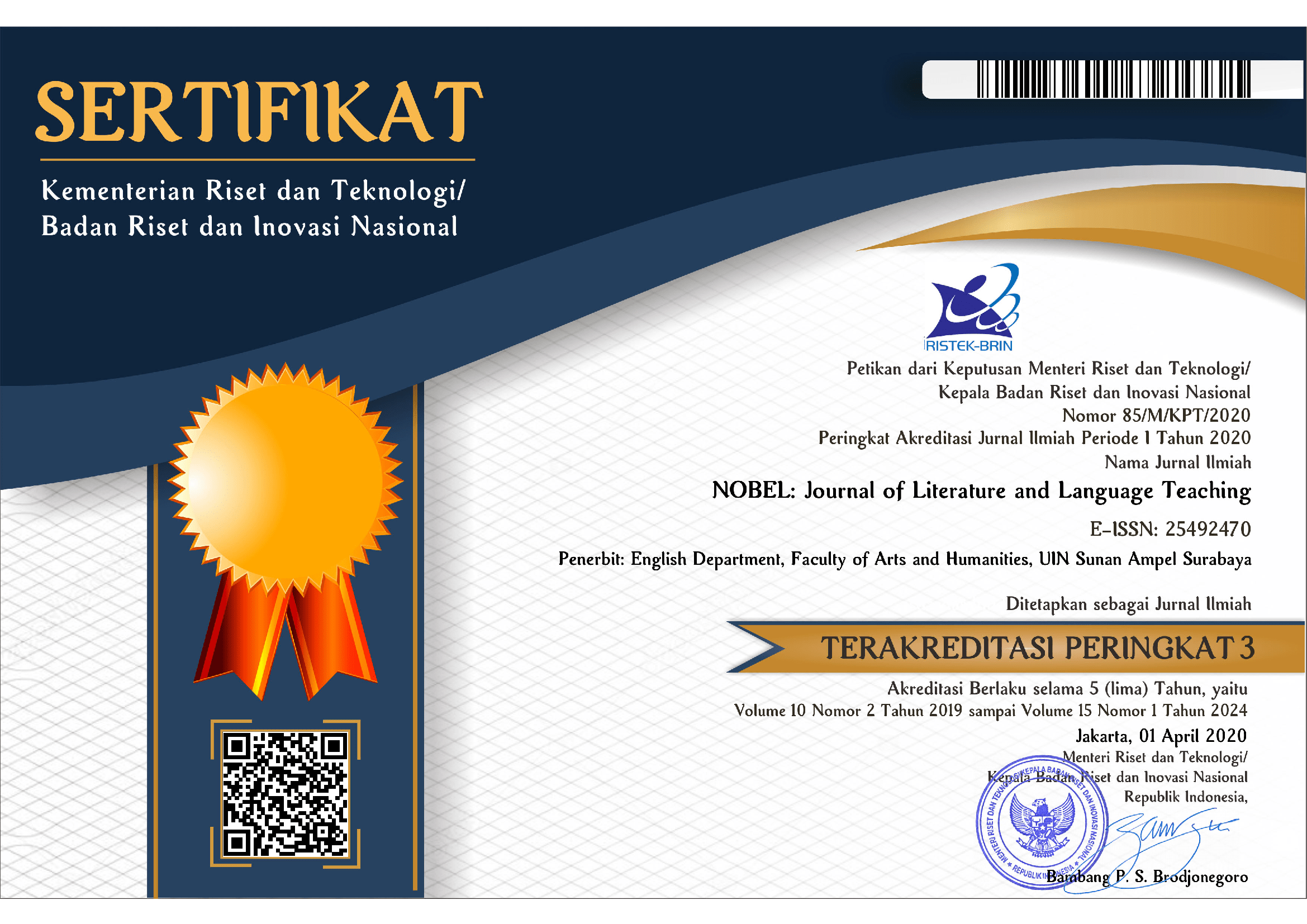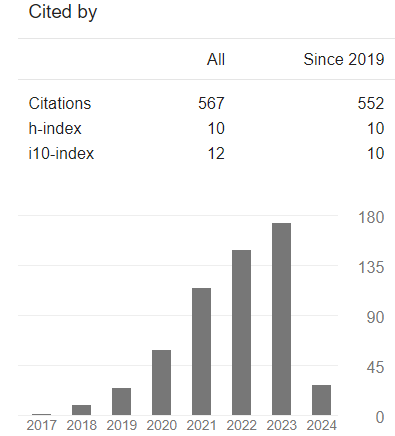Language Anxiety Experienced by English Department Freshmen of Wijaya Kusuma University Surabaya
DOI:
https://doi.org/10.15642/NOBEL.2022.13.2.231-241Keywords:
language anxiety, level, type, freshmenAbstract
This research aims to describe the language anxiety level and type frequently experienced by English Department first-year students of Wijaya Kusuma University Surabaya. It used a case study as the research design to explain the phenomenon observed. The research participants were twenty-eight English Department first-year students of Wijaya Kusuma University Surabaya. Each of them was given a five-point Likert scale questionnaire adapted from Foreign Language Classroom Anxiety Scale developed by Horwitz et al. (1986). The findings unveiled that most first-year students experienced moderate language anxiety levels in which they frequently experienced the fear of negative evaluation. It is suggested that future researchers explore the students’ anxiety levels and types by considering their learning proficiency and habit.
Downloads
References
Al-Khasawneh, F. M. (2016). Investigating foreign language learning anxiety: A case of Saudi undergraduate EFL learners. Journal of Language and Linguistic Studies, 12(1), 137–148. http://jlls.org/index.php/jlls/article/view/470
Al-Saggaf, M. A., Zawawi, F. A. N. binti M., & Al-Aidaros, A. H. (2021). Level of language anxiety in classroom among students in a higher education institute in Malaysia. Studies in Humanities and Education, 2(1), 45–55. https://doi.org/10.48185/SHE.V2I1.173
Alqahtani, S. M. (2019). The impact of language anxiety on EFL learners’ proficiency: Case study of University of Jeddah. Adalya Journal, 8(12), 844–864. https://doi.org/https://doi.org/16.10089.AJ.2019.V8I12.285311.6675
Ansari, M. S. (2015). Speaking anxiety in ESL/EFL classrooms: A holistic approach and practical study. International Journal of Education Investigations, 2(4), 38–46. http://ijeionline.com/attachments/article/41/IJEIonline_Vol.2_No.4_2015-4-04.pdf
Ary, D., Jacobs, L. C., Razavieh, A., & Sorensen, C. K. (2010). Introduction to research in education (8th ed.). Cengage Learning.
Aydin, S. (2009). Test anxiety among foreign language learners: A review of literature. Journal of Language and Linguistic Studies, 5(1), 127–137. http://www.jlls.org/index.php/jlls/article/view/77/77
Aydin, S., Denkci-Akkas, F., Turnuk, T., Basturk-Beydilli, A., & Saydam, I. (2021). A descriptive study on test anxiety among foreign language learners. Futuristic Implementation of Research in Education (FIRE), 2(2), 43–55. http://firejournal.org/index.php/fire/article/view/47
Batiha, J. M., Mustaffa, R. M., & Noor, N. M. (2018). Foreign language speaking anxiety of Jordanian freshman English learners. Akademika, 88(1), 153–165. https://doi.org/https://doi.org/10.17576/akad-2018-8801-11
Horwitz, E. (2001). Language anxiety and achievement. Annual Review of Applied Linguistics, 21(1), 112–126. https://doi.org/10.1017/S0267190501000071
Horwitz, E. K., Horwitz, M. B., & Cope, J. (1986). Foreign language classroom anxiety. The Modern Language Journal, 70(2), 125–132. https://doi.org/10.2307/327317
Jawad, Z. A., & Al-Obaydi, L. H. (2015). Investigating the effect of language anxiety on student-teachers’ oral performance. Proceedings the 8th Scientific Conference of the College of Education for Human Science, 1–20. https://www.researchgate.net/publication/309666932_Investigating_the_Effect_of_Language_Anxiety_on_Student-Teachers’_Oral_Performance
MacIntyre, P. D., & Gardner, R. C. (1991). Methods and results in the study of anxiety and language learning: A review of the literature. Language Learning, 41(1), 85–117. https://doi.org/10.1111/j.1467-1770.1991.tb00677.x
MacIntyre, P. D., & Gardner, R. C. (1994). The subtle effects of language anxiety on cognitive processing in the second language. Language Learning, 44(2), 283–305. https://doi.org/10.1111/j.1467-1770.1994.tb01103.x
Manipuspika, Y. S. (2018). Correlation between anxiety and willingness to communicate in the Indonesian EFL context. Arab World English Journal, 9(2), 200–217. https://doi.org/10.24093/awej/vol9no2.14
McCroskey, J. C., Daly, J. A., & Sorensen, G. (1976). Personality correlates of communication apprehension: A research note. Human Communication Research, 2(4), 376–380. https://doi.org/10.1111/J.1468-2958.1976.TB00498.X
Metcalfe, J. (2017). Learning from errors. Annual Review of Psychology, 68(1), 465–489. https://doi.org/10.1146/annurev-psych-010416-044022
Mhuentoei, R. (2021). Speaking anxiety and related factors of first-year students towards foreign language class. Journal of Business Administration and Languages (JBAL), 9(2), 78–84. https://so06.tci-thaijo.org/index.php/TNIJournalBA/article/view/249681
Putri, N. M., & Marlina, L. (2019). An analysis of students’ speaking anxiety faced by the EFL freshman students at English Department of Universitas Negeri Padang. Journal of English Language Teaching, 8(4), 459–471. https://doi.org/10.24036/jelt.v8i4.106565
Rafek, M., Ramli, N. H. L., & Hassan, J. (2018). Language and gender: Fear of evaluation in second language learning. International Journal of Academic Research in Business and Social Sciences, 8(1), 524–533. https://doi.org/10.6007/IJARBSS/v8-i1/3825
Sadeghi, K., Mohammadi, F., & Sedaghatghoftar, N. (2013). From EFL classroom into the mainstream: A socio-cultural investigation of speaking anxiety among female EFL learners. International Journal of Society, Culture & Language, 1(2), 117–132. http://www.ijscl.net/&url=http://www.ijscl.net/article_2700.html
Salehi, M., & Marefat, F. (2014). The effects of foreign language anxiety and test anxiety on foreign language test performance. Theory and Practice in Language Studies, 4(5), 931–940. https://doi.org/10.4304/tpls.4.5.931-940
Sham, R. M., & Azmi, M. N. L. (2018). Causal relationship between oral performance and communication apprehension. KnE Social Sciences, 3(4), 769–783. https://doi.org/10.18502/kss.v3i4.1984
Suryani, R. W. (2018). Building positive teacher-students relationship. Proceedings of 3rd International Conference on Education 2018: Teachers in the Digital Age, 263–268. https://ojs.iainbatusangkar.ac.id/ojs/index.php/proceedings/article/view/1317
Taye, B. A. (2018). Language anxiety and achievement among first year students of Addis Ababa University, Ethiopia. African Journal of Teacher Education, 7(2). https://doi.org/10.21083/ajote.v7i2.3920
Trifoni, A., & Shahini, M. (2011). How does exam anxiety affect the performance of university students? Mediterranean Journal of Social Sciences, 2(2), 93–100. https://www.richtmann.org/journal/index.php/mjss/article/view/10785/10398
Watson, D., & Friend, R. (1969). Measurement of social-evaluative anxiety. Journal of Consulting and Clinical Psychology, 33(4), 448–457. https://doi.org/10.1037/h0027806
Downloads
Published
How to Cite
Issue
Section
License
Copyright (c) 2022 NOBEL: Journal of Literature and Language Teaching

This work is licensed under a Creative Commons Attribution 4.0 International License.







